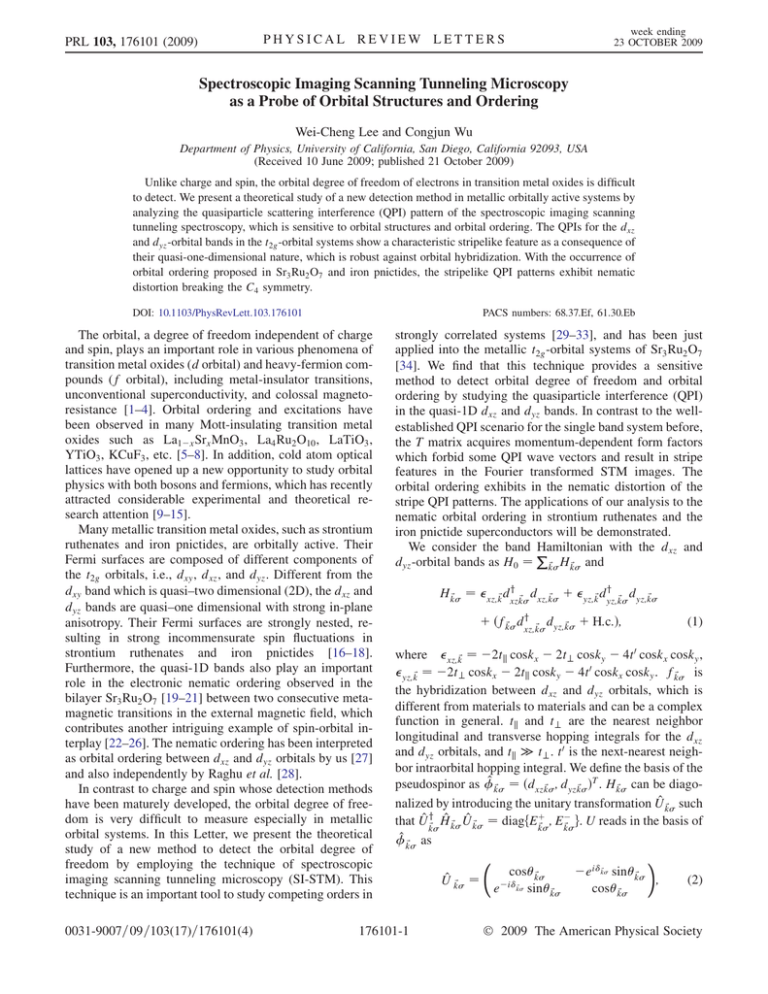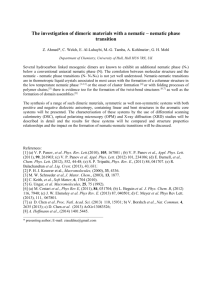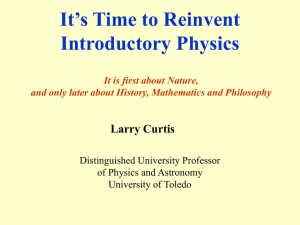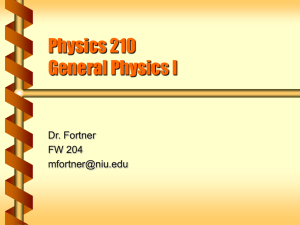Spectroscopic Imaging Scanning Tunneling Microscopy Wei-Cheng Lee and Congjun Wu
advertisement

week ending 23 OCTOBER 2009 PHYSICAL REVIEW LETTERS PRL 103, 176101 (2009) Spectroscopic Imaging Scanning Tunneling Microscopy as a Probe of Orbital Structures and Ordering Wei-Cheng Lee and Congjun Wu Department of Physics, University of California, San Diego, California 92093, USA (Received 10 June 2009; published 21 October 2009) Unlike charge and spin, the orbital degree of freedom of electrons in transition metal oxides is difficult to detect. We present a theoretical study of a new detection method in metallic orbitally active systems by analyzing the quasiparticle scattering interference (QPI) pattern of the spectroscopic imaging scanning tunneling spectroscopy, which is sensitive to orbital structures and orbital ordering. The QPIs for the dxz and dyz -orbital bands in the t2g -orbital systems show a characteristic stripelike feature as a consequence of their quasi-one-dimensional nature, which is robust against orbital hybridization. With the occurrence of orbital ordering proposed in Sr3 Ru2 O7 and iron pnictides, the stripelike QPI patterns exhibit nematic distortion breaking the C4 symmetry. DOI: 10.1103/PhysRevLett.103.176101 PACS numbers: 68.37.Ef, 61.30.Eb The orbital, a degree of freedom independent of charge and spin, plays an important role in various phenomena of transition metal oxides (d orbital) and heavy-fermion compounds (f orbital), including metal-insulator transitions, unconventional superconductivity, and colossal magnetoresistance [1–4]. Orbital ordering and excitations have been observed in many Mott-insulating transition metal oxides such as La1x Srx MnO3 , La4 Ru2 O10 , LaTiO3 , YTiO3 , KCuF3 , etc. [5–8]. In addition, cold atom optical lattices have opened up a new opportunity to study orbital physics with both bosons and fermions, which has recently attracted considerable experimental and theoretical research attention [9–15]. Many metallic transition metal oxides, such as strontium ruthenates and iron pnictides, are orbitally active. Their Fermi surfaces are composed of different components of the t2g orbitals, i.e., dxy , dxz , and dyz . Different from the dxy band which is quasi–two dimensional (2D), the dxz and dyz bands are quasi–one dimensional with strong in-plane anisotropy. Their Fermi surfaces are strongly nested, resulting in strong incommensurate spin fluctuations in strontium ruthenates and iron pnictides [16–18]. Furthermore, the quasi-1D bands also play an important role in the electronic nematic ordering observed in the bilayer Sr3 Ru2 O7 [19–21] between two consecutive metamagnetic transitions in the external magnetic field, which contributes another intriguing example of spin-orbital interplay [22–26]. The nematic ordering has been interpreted as orbital ordering between dxz and dyz orbitals by us [27] and also independently by Raghu et al. [28]. In contrast to charge and spin whose detection methods have been maturely developed, the orbital degree of freedom is very difficult to measure especially in metallic orbital systems. In this Letter, we present the theoretical study of a new method to detect the orbital degree of freedom by employing the technique of spectroscopic imaging scanning tunneling microscopy (SI-STM). This technique is an important tool to study competing orders in 0031-9007=09=103(17)=176101(4) strongly correlated systems [29–33], and has been just applied into the metallic t2g -orbital systems of Sr3 Ru2 O7 [34]. We find that this technique provides a sensitive method to detect orbital degree of freedom and orbital ordering by studying the quasiparticle interference (QPI) in the quasi-1D dxz and dyz bands. In contrast to the wellestablished QPI scenario for the single band system before, the T matrix acquires momentum-dependent form factors which forbid some QPI wave vectors and result in stripe features in the Fourier transformed STM images. The orbital ordering exhibits in the nematic distortion of the stripe QPI patterns. The applications of our analysis to the nematic orbital ordering in strontium ruthenates and the iron pnictide superconductors will be demonstrated. We consider the band P Hamiltonian with the dxz and dyz -orbital bands as H0 ¼ k ~ Hk ~ and y y Hk ~ þ yz;k~ dyz;k ~ ~ ¼ xz;k~ dxzk ~ dxz;k ~ dyz;k y þ ðfk ~ þ H:c:Þ; ~ dxz;k ~ dyz;k (1) where xz;k~ ¼ 2tk coskx 2t? cosky 4t0 coskx cosky , is yz;k~ ¼ 2t? coskx 2tk cosky 4t0 coskx cosky . fk ~ the hybridization between dxz and dyz orbitals, which is different from materials to materials and can be a complex function in general. tk and t? are the nearest neighbor longitudinal and transverse hopping integrals for the dxz and dyz orbitals, and tk t? . t0 is the next-nearest neighbor intraorbital hopping integral. We define the basis of the T pseudospinor as ^ k ~ ¼ ðdxzk ~ can be diago~ ; dyzk ~ Þ . Hk nalized by introducing the unitary transformation U^ k ~ such y ^ þ ^ ^ that Uk ~ Uk ~ ¼ diagfEk ~ ; Ek ~ g. U reads in the basis of ~ H k ^ k ~ as 176101-1 U^ k ~ ¼ cosk ~ ~ sin eik ~ k ! ~ sin eik ~ k ; cosk ~ (2) Ó 2009 The American Physical Society PHYSICAL REVIEW LETTERS PRL 103, 176101 (2009) where tan2k ~ ¼ 2jfk ~ j xz;k~ yz;k~ , k ~ ¼ Argðfk; ~ Þ. The eigen- values and the corresponding eigenvectors are E ~ ¼ k qffiffiffiffiffiffiffiffiffiffiffiffiffiffiffiffiffiffiffiffiffiffiffiffiffiffiffiffiffiffiffiffiffiffiffiffiffiffiffiffiffiffiffiffiffiffiffiffiffiffiffi 2 ðxz;k~ þ yz;k~ ðxz;k~ yz;k~ Þ2 þ 4jfk ~ j Þ=2 and c k ~ ¼ y ^ T ^ ð ~ ; ~ Þ ¼ U ~ , respectively. þ;k ;k ~ k k Next we introduce the scattering Hamiltonian for the nonmagnetic single impurity at r~i . Assuming the isotropy of the impurity, Himp does not mix dxz and dyz orbitals as P Himp ¼ V0 i ðdyxz;i dxz;i þ dyyz;i dyz;i Þi;r~i , where we set the impurity location r~i ¼ ð0; 0Þ at the origin. In the basis of the band eigenfunction c k ~ , Himp is expressed as Himp ¼ 1 X ^ y ^ c k;a V k;~ k~0 ;ab c^ k~0 ;b ; ~ N ~ ~0 (3) k;k ; ^ where V^ k;~ k~0 ;ab ¼ V0 ½U^ yk ~ U k~0 ab is the effective scattering matrix, and a, b ¼ are eigenband indices. This momentum dependence generated by the orbital hybridization has nontrivial consequences in the QPI spectra shown later. The Green functions with the impurity satisfy ~ k~0 Þ ¼ G^ 0; ðkÞ ~ ~ ~0 þ G^ 0; ðkÞ ~ T^ 0 G^ 0; ðk~0 Þ; G^ ðk; ~ k~ k;k k; (4) ^ G^ 0 , and the T matrix are 2 2 matrices in terms where G, of band indices. The T matrix and the bare Green’s func~ defined as tions G^ 0; ðkÞ 1 X ^ ^ ~ T^ p;~ k~0 ; V G ðpÞ T^ k;~ k~0 ¼ V^ k;~ k~0 þ N p~ k;~ p~ 0; (5) a Þ . ~ and ½G^ 1 a;b 0; ðkÞab ¼ ð! þ i Ek ~ In previous theoretical analysis of QPI [31], the single impurity T matrix was simplified as momentum independent for the single band systems. This simplification is no longer valid in hybridized quasi-1D bands of dxz and dyz . In the following, we consider a square lattice containing 41 41 sites and solve the momentum-dependent T matrix numerically. The local density of states at energy E, which is proportional to the conductance (dI=dV) measured by the STM, and its Fourier transformation (FT-STM) can be calculated as 1 X ~ ~0 ð~r; EÞ ¼ Imfeiðkk Þ~r N ~ ~0 week ending 23 OCTOBER 2009 case, the Fermi surface of each band is a set of two straight lines located at kx ¼ kF (ky ¼ kF ) for dxz (dyz ) bands as shown in the Fig. 1(a). Because the density of states (DOS) is uniform along the Fermi surface, all the quasiparticle scatterings on the Fermi surface are equally important. The quasiparticle scatterings occur either within the same ‘‘Fermi lines’’ [Fig. 1(a)] giving rise to the stripes on the x^ and y^ axes in the FT-STM image [Fig. 1(b)], or between the different ‘‘Fermi lines’’ [Fig. 1(a)] leading to the remaining weaker stripes in Fig. 1(b). These weaker stripes appearing at the lines of qx ¼ 2kF and qy ¼ 2kF are the quasi-1D analogues of Friedel oscillation in exact 1D systems. Note that all the QPIs have C4 symmetry because we assume that the dxz and dyz bands are degenerate and no spontaneous nematic order is present. With turning on the hybridization, naively it may be expected that these stripe features should disappear since the Fermi surfaces are 2D-like. However, we will show explicitly that due to the momentum-dependent T matrix some quasiparticle scatterings on the Fermi surfaces are greatly suppressed even as the DOS of k~ points are large. As a result, the stripe features still survive as long as the Fermi surfaces remain connected. This unique feature distinguishes the hybridized quasi-1D bands from a single 2D band, for example, the dxy band with similar Fermi surface topology. Below we consider the on-site spin-orbit (SO) coupling P HSO ¼ i L~ i S~i to hybridize the dxz and dyz bands [28,35]. Projecting it onto the dxz and dyz subspace, we obtain the hybridization function as fk ~ ¼ i=2. Consequently, the effective scattering matrix V^ k;~ k~0 ;ab in the eigenband basis becomes V^ k;~ k~0 ¼ V0 cosðk~ k~0 Þ i sinðk~ k~0 Þ i sinðk~ k~0 Þ ; (7) cosðk~ k~0 Þ ;k;k ^ ~ ~0 ^y Tr½U^ k; ~ G ðk; k ; EÞU k~0 ; g; ~ EÞ ¼ ðq; (6) 1 X iq e ~ r~ ð~r; EÞ: N r~ Note that in all the FT-STM images presented below, ðq~ ¼ 0; EÞ are removed to reveal the weaker QPI [31], ~ EÞ are plotted. and the absolute intensities of ðq; We start with a heuristic example of ideal quasi-1D case in which only tk is nonzero without hybridization. In this FIG. 1 (color online). (a) The Fermi surfaces with an ideal quasi-1D bands without hybridization and (b) the corresponding FT-STM image. The stripe features in (b) at qx ¼ 0 and qy ¼ 0 result from the quasiparticle scatterings indicated by arrows within the same lines in (a), and those appearing at qx ¼ 2kF and qy ¼ 2kF come from scatterings indicated by arrows between different lines in (a), echoing the Friedel oscillation in exact 1D case. 176101-2 PRL 103, 176101 (2009) PHYSICAL REVIEW LETTERS where tan2k~ ¼ =ðxz;k~ yz;k~ Þ. The diagonal terms (the intraband scattering) are modulated by the form factor of cosðk~ k~0 Þ, which is suppressed around k~ k~0 =2 is enhanced around k~ k~0 0. For the aid to eyes, the values of the k~ are represented by the background gray scales plotted in Figs. 2(a), 2(c), and 3(a), showing white for k~ ! 0 and dark gray for k~ ! =2. Since the larger V^ k;~ k~0 leads to the larger T^ k;~ k~0 , the QPI wave vectors connecting two k~ points from different color areas have vanishing weights in the FT-STM images. In the hybridized dxz and dyz bands, the DOS van Hove (vH) singularity occurs at X~ ¼ ð; 0Þ and X~ 0 ¼ ð0; Þ. Figure 2 summarizes the results for energies below and above the vH singularity. The model parameters are chosen as ðtk ; t? ; t0 ; ; V0 Þ ¼ ð1:0; 0:1; 0:025; 0:2; 1:0Þ consistent with those in Refs. [27,28,35]. In Fig. 2(b), the stripe features remain dominant in the FT-STM images at energy below the vH singularity as explained below. Although Fermi surface is a 2D closed loop shown in Fig. 2(a), the QPI wave vectors corresponding to scatterings indicated by the solid arrows are prohibited due to the angular form FIG. 2 (color online). Fermi surfaces (dashed lines) of the two quasi-1D bands at energies (a) just below the vH singularity (E ¼ 1:8) and (c) just above the vH singularity (E ¼ 2:0). The corresponding FT-STM images are presented in (b) and (d). The background gray scale in (a) and (c) represents the values of k~ , exhibiting from white to dark gray for k~ ¼ 0 ! 2 . The scatterings between two k~ points in areas with different colors (indicated by the solid arrows) are strongly suppressed. The striped pattern disappears and discrete QPI wave vector points become dominant when the Fermi surface breaks down to discrete segments. The dashed arrows in (a) and (c) refer to the scatterings responsible for the strongest features in the FT-STM images. week ending 23 OCTOBER 2009 factor discussed above. The dominant scatterings still occur in the same way as discussed in Fig. 1(a), except several q~ vectors on the stripes have stronger features because of the small variations of the DOS introduced by t? and t0 . As energy crosses the vH singularity, the topology of the Fermi surface turns into discrete segments as shown in Fig. 2(c). The stripe features of the QPI wave vectors disappear and instead they become several discrete points whose positions depend on the model parameters. As the energy is very close to the vH singularity, it has been shown in Refs. [27,28] that the spontaneous nematic order appears with multiband Hubbard interactions, which gives an anisotropic renormalization of dispersion of 0xz;k~ ¼ xz;k~ þ and 0yz;k~ ¼ yz;k~ . Figure 3 plots the Fermi surface and the FT-STM image for the ground state with ¼ 0:05. The stripe features only extend along one particular direction and breaks the C4 symmetry down to C2 symmetry, as expected for a nematic order. Now we connect the above discussion to the bilayer Sr3 Ru2 O7 system which has the additional Fermi surfaces of the quasi-2D dxy band and the bilayer structure. The interband scatterings between the quasi-2D and 1D bands are also suppressed due to the similar reason of different orbital nature presented above. The QPI pattern of the intra dxy -band scattering should follow the similar analysis published before [29,31]. The quasi-1D bands of dxz and dyz have large bilayer splittings resulting in bonding and antibonding versions. Usually the impurity only lies in one layer and, thus, breaks the bilayer symmetry and induces both intraband and interband scatterings among bonding and antibonding bands. And all of them should have the stripe pattern illustrated before. The change of the FT-STM images as energy across the vH singularity can be used to distinguish the orbital configuration of the Fermi surface responsible for the nematic ordering observed in Sr2 Ru3 O7 , which has been proposed both in the quasi-2D dxy band [22–24] and the quasi-1D bands of dxz and dyz [27,28]. Both proposals have similar Fermi surface topology, but the QPIs will be very different. FIG. 3 (color online). (a) Fermi surface and (b) FT-STM image of the two quasi-1D band model for Sr3 Ru2 O7 with nematic order right at the van Hove singularity (E ¼ 1:9). 176101-3 PRL 103, 176101 (2009) PHYSICAL REVIEW LETTERS The stripe features are direct consequences of the quasi-1D bands which have comparable DOS on the Fermi surfaces. For the 2D dxy bands, the QPIs are dominated by several discrete q~ vectors connecting k~ points with largest DOS as has been demonstrated nicely in the high-Tc cuprate Bi2 Sr2 CaCu2 O8þ [29]. Accordingly, we predict that if it is the 2D dxy band responsible for the nematic order, the FT-STM will show similar QPIs containing several discrete q~ vectors as the magnetic field is tuned through the critical point for the nematic order, while a significant change in the topologies of QPIs from Fig. 2(b) ! Fig. 3(b) ! Fig. 2(d) will be seen if the hybridized dxz and dyz bands are responsible. These results may also apply to the iron pnictide superconductors with multiple Fermi surface sheets: 1;2 bands located near the point composed mostly of dxz and dyz orbitals and 1;2 bands residing near X and X 0 points with large fraction of dxy orbital [36,37]. Given that the tunneling rate along the z^ direction is strongly suppressed with the increase of magnitude of in-plane momentum jk~k j [38], the tunneling matrix elements of 1;2 bands are naturally to be much smaller than those of 1;2 bands. The similar suppression of tunneling matrix elements at large in-plane momentum has been demonstrated in the graphene systems [39]. As a result, SI-STM is expected to observe mostly the QPI scatterings from the 1;2 bands, and therefore the stripe features should be observed with a length roughly the size of the 1;2 pockets in the normal state of the iron pnictides. More interestingly, it has been suggested [40] based on a recent neutron scattering measurement performed on the undoped CaFe2 As2 that a Heisenberg model with highly anisotropic in-plane exchange interactions is required to fit the spin-wave dispersion, indicating the possibility of nematic order [41]. Besides, the nematic order in LaOFeAs compound has also been theoretically predicted [18,42,43]. If such nematic order exists, the stripe features along one certain direction resembling Fig. 3(b) should be observable in the FT-STM image. In conclusion, we have performed the theoretical investigation of a new detection method to the orbital degree of freedom and the orbital ordering in metallic transition metal oxides. For the quasi-1D dxz and dyz bands in the t2g -orbital systems, the Fourier transformed STM image of the QPIs exhibit the stripe pattern. When the orbital hybridization is present, the T matrix becomes momentum dependent even for a single impurity problem and will suppress some QPI wave vectors depending on the hybridization angle k~ . The consequences of the orbital ordering in Sr3 Ru2 O7 and the iron pnictide superconductors have been pointed out as a nematic distortion of the stripe pattern of the QPI. We are grateful to J. C. Davis for his experiment results before publication and helpful discussion. This work is week ending 23 OCTOBER 2009 supported by ARO-W911NF0810291 and the Sloan Research Foundation. [1] M. Imada, A. Fujimori, and Y. Tokura, Rev. Mod. Phys. 70, 1039 (1998). [2] Y. Tokura and N. Nagaosa, Science 288, 462 (2000). [3] G. Khaliullin, Prog. Theor. Phys. Suppl. 160, 155 (2005). [4] D. I. Khomskii, Phys. Scr. 72, CC8 (2005). [5] Y. Murakami et al., Phys. Rev. Lett. 80, 1932 (1998). [6] C. Ulrich et al., Phys. Rev. B 77, 113102 (2008). [7] H. Ichikawaa et al., Physica (Amsterdam) 281B–282B, 482 (2000). [8] P. Khalifah et al., Science 297, 2237 (2002). [9] T. Müller et al., Phys. Rev. Lett. 99, 200405 (2007). [10] W. V. Liu and C. Wu, Phys. Rev. A 74, 013607 (2006). [11] C. Wu et al., Phys. Rev. Lett. 97, 190406 (2006). [12] C. Wu, Phys. Rev. Lett. 100, 200406 (2008). [13] C. Wu, Phys. Rev. Lett. 101, 186807 (2008). [14] C. Wu, Mod. Phys. Lett. B 23, 1 (2009). [15] W.-C. Lee, C. Wu, and S. Das Sarma, arXiv:0905.1146. [16] A. P. Mackenzie and Y. Maeno, Rev. Mod. Phys. 75, 657 (2003). [17] I. Mazin and J. Schmalian, arXiv:0901.4790. [18] H. Zhai, F. Wang, and D.-H. Lee, Phys. Rev. B 80, 064517 (2009). [19] S. A. Grigera et al., Science 294, 329 (2001). [20] S. A. Grigera et al., Science 306, 1154 (2004). [21] R. A. Borzi et al., Science 315, 214 (2007). [22] H.-Y. Kee and Y. B. Kim, Phys. Rev. B 71, 184402 (2005). [23] C. Puetter, H. Doh, and H.-Y. Kee, Phys. Rev. B 76, 235112 (2007). [24] H. Yamase and A. Katanin, J. Phys. Soc. Jpn. 76, 073706 (2007). [25] A. Tamai et al., Phys. Rev. Lett. 101, 026407 (2008). [26] J. F. Mercure et al., arXiv:0902.3937 [Phys. Rev. Lett. (to be published)]. [27] W.-C. Lee and C. Wu, Phys. Rev. B 80, 104438 (2009). [28] S. Raghu et al., Phys. Rev. B 79, 214402 (2009). [29] Y. Kohsaka et al., Nature (London) 454, 1072 (2008). [30] T. Hanaguri et al., Nature Phys. 3, 865 (2007). [31] Q.-H. Wang and D.-H. Lee, Phys. Rev. B 67, 020511 (2003). [32] A. V. Balatsky, I. Vekhter, and J.-X. Zhu, Rev. Mod. Phys. 78, 373 (2006). [33] Y. Yin et al., Phys. Rev. Lett. 102, 097002 (2009). [34] J. C. Davis (private communication). [35] I. Eremin, D. Manske, and K. Bennemann, Phys. Rev. B 65, 220502 (2002). [36] K. Kuroki et al., Phys. Rev. Lett. 101, 087004 (2008). [37] S. Graser et al., New J. Phys. 11, 025016 (2009). [38] J. Tersoff and D. Hamann, Phys. Rev. Lett. 50, 1998 (1983). [39] Y. Zhang et al., Nature Phys. 4, 627 (2008). [40] J. Zhao et al., Nature Phys. 5, 555 (2009). [41] R. R. Singh, arXiv:0903.4408. [42] C. Fang et al., Phys. Rev. B 77, 224509(R) (2008). [43] C. Xu et al., Phys. Rev. B 78, 020501 (2008). 176101-4



